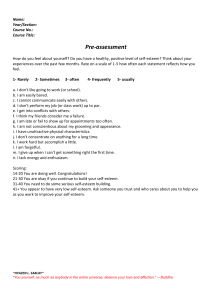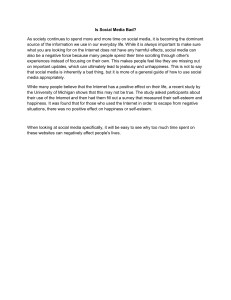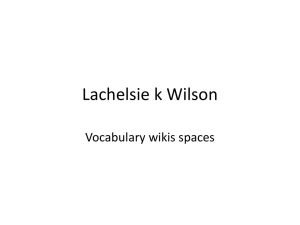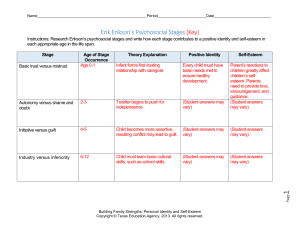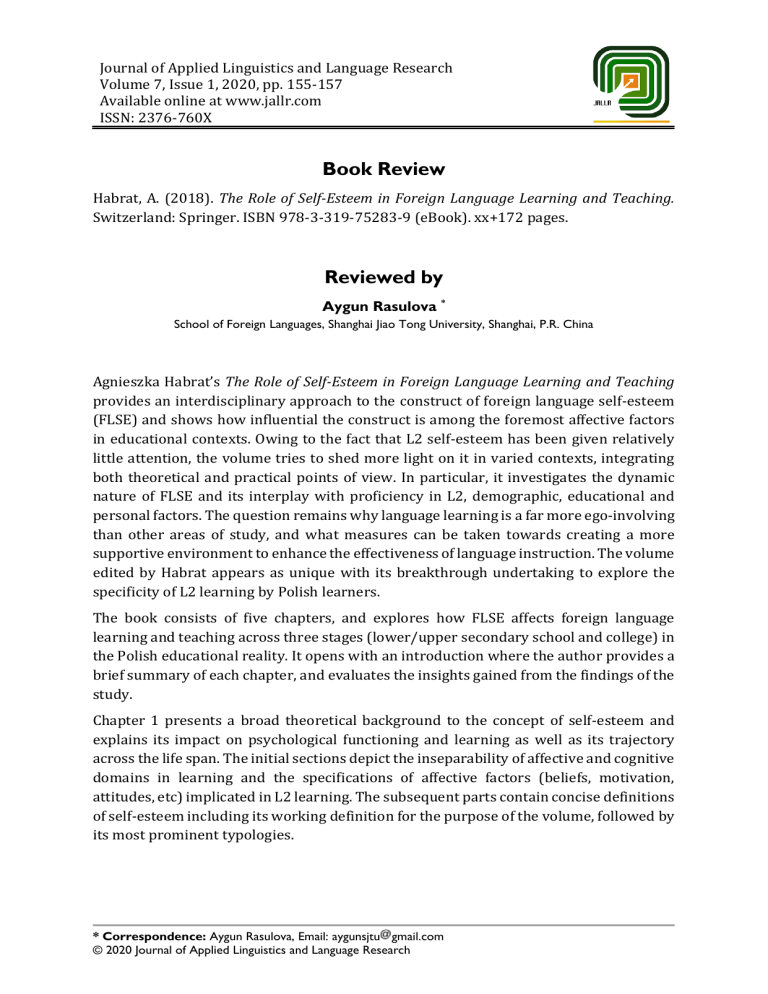
Journal of Applied Linguistics and Language Research Volume 7, Issue 1, 2020, pp. 155-157 Available online at www.jallr.com ISSN: 2376-760X Book Review Habrat, A. (2018). The Role of Self-Esteem in Foreign Language Learning and Teaching. Switzerland: Springer. ISBN 978-3-319-75283-9 (eBook). xx+172 pages. Reviewed by Aygun Rasulova * School of Foreign Languages, Shanghai Jiao Tong University, Shanghai, P.R. China Agnieszka Habrat’s The Role of Self-Esteem in Foreign Language Learning and Teaching provides an interdisciplinary approach to the construct of foreign language self-esteem (FLSE) and shows how influential the construct is among the foremost affective factors in educational contexts. Owing to the fact that L2 self-esteem has been given relatively little attention, the volume tries to shed more light on it in varied contexts, integrating both theoretical and practical points of view. In particular, it investigates the dynamic nature of FLSE and its interplay with proficiency in L2, demographic, educational and personal factors. The question remains why language learning is a far more ego-involving than other areas of study, and what measures can be taken towards creating a more supportive environment to enhance the effectiveness of language instruction. The volume edited by Habrat appears as unique with its breakthrough undertaking to explore the specificity of L2 learning by Polish learners. The book consists of five chapters, and explores how FLSE affects foreign language learning and teaching across three stages (lower/upper secondary school and college) in the Polish educational reality. It opens with an introduction where the author provides a brief summary of each chapter, and evaluates the insights gained from the findings of the study. Chapter 1 presents a broad theoretical background to the concept of self-esteem and explains its impact on psychological functioning and learning as well as its trajectory across the life span. The initial sections depict the inseparability of affective and cognitive domains in learning and the specifications of affective factors (beliefs, motivation, attitudes, etc) implicated in L2 learning. The subsequent parts contain concise definitions of self-esteem including its working definition for the purpose of the volume, followed by its most prominent typologies. * Correspondence: Aygun Rasulova, Email: aygunsjtu gmail.com © 2020 Journal of Applied Linguistics and Language Research Book Review: Habrat, A. (2018). The Role of Self-Esteem in Foreign Language … 156 After providing readers with a comprehensive theoretical and psychological background of the construct, in Chapter 2 the author proceeds to survey the findings of selected empirical research on self-esteem from a multidimensional perspective. While acknowledging the complexity of the construct and its value for human behavior, the chapter contains a separate section examining the interaction between self-esteem and different aspects of psychological functioning such as social interaction, creativity and antisocial behavior. The main aim of Chapter 3 is to introduce the major results of the study together with its limitations. It commences with the main objectives and scope of the research, followed by a detailed description of the participants, as well as the methods undertaken by the author. As Mruk postulates, “combining qualitative and quantitative approaches to selfesteem research may well be the optimal solution that is most likely to do justice the complexity of the phenomenon” (p.51). With this notion, using an integrated approach the author manages to elucidate understanding of the characteristics of FLSE and claims success in L2 learning depends more on what happens inside the learner rather than on external factors. Chapter 4 is devoted to a broader interpretation of the results justifying the theoretical claims laid out in Chapter 1. First, it discusses the analysis of changes that foreign language self-esteem undergoes over time and with growing proficiency. Second, the most significant correlates and predictors of L2 self-esteem are examined by their sheer relevance in the context of success or failure in SLA. Subsequently, the Ideal L2- Self, language anxiety, learning strategies and learning beliefs are thoroughly discussed together with their prominent contribution to the level of FLSE. Third, the chapter includes an overview of high and low self-esteem learner traits and behaviors which may help instructors understand the significance of the learners’ unique profiles and diverse needs. The final chapter draws a conclusion concerning the findings discussed in the previous chapters, proposing alternative research designs and instruments for further research directions. Moreover, the chapter offers a set of pedagogical implications as to what can be done by class instructors catering a more learner-friendly atmosphere conducive to fostering learners’ positive and healthy self-esteem. The references which the study builds on claim that self-esteem undergoes fluctuations during adolescence, accompanied by cognitive maturation, pubertal changes and school transitions. The study reveals that the level of FLSE grows slightly with learning experience, but increases solidly with the intensity of instruction. However, its level was not steady in all three stages of education and a notable decrease was observed on the upper secondary level. As expected, it may relate to school-leaving exam (Matura examination), and the special characteristics of the learners in this age group which brings more tension and language anxiety into this educational stage. It might seem that this phenomenon activates a fear of negative evaluation, where learners are more anxious about making mistakes, which ultimately leads to passivity and low proficiency in language attainment. Journal of Applied Linguistics and Language Research, 2020, 7(1) 157 While a number of valuable contributions have been carried out within the field of educational psychology, many questions about L2 self-esteem have not been thoroughly answered yet. The author acknowledges it is partially due to the diversity of the definitions of the construct, and challenges in measuring self-esteem, which hinder much empirical research in this field. The main value of the volume lies in its innovative character as it contributes to understanding foreign language self-esteem against the Polish educational background and its pedagogical implications. By merging elements of linguistic and psychological exploration, the study tries to fill the gaps between the areas of foreign language selfesteem and FL learning, and thereby ratifies its weighty role in L2 learning process. Although the volume makes a valuable and innovative contribution to the field, there are inevitable limitations. It is worth noting that the outcome of the research is rather specific, so it may not be applicable to other cultures due to fact that Polish self-esteem is derived more from an individualistic culture rather than collectivistic. In order to provide a comprehensive view of the facets of the self, the volume can be enriched by including more cross-cultural comparisons. Despite the limitation, the book still remains a valuable resource for readers who are interested in naturalistic and classroom second language acquisition.


